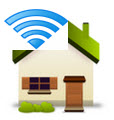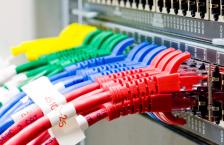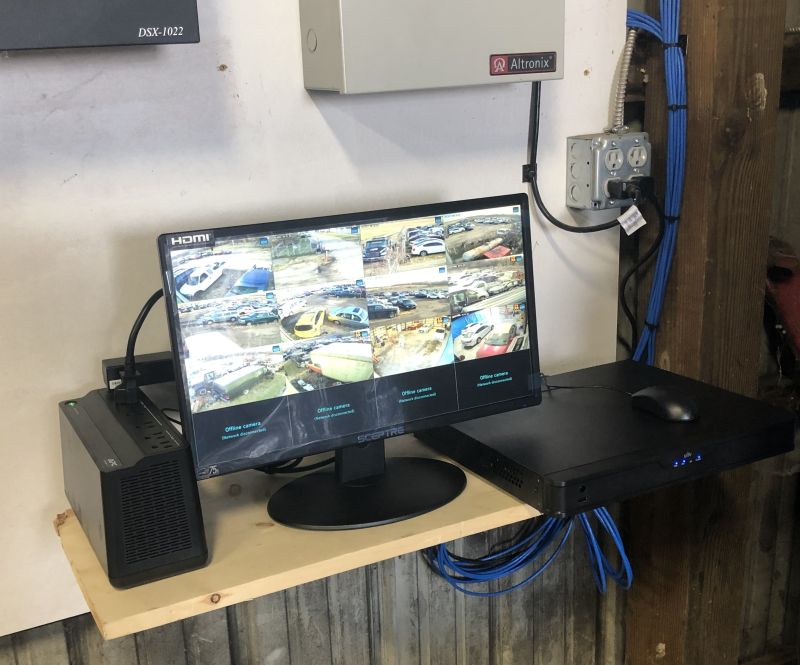In the ever-evolving world of networking technology, two titans stand tall: Ethernet and fiber optic cables. As a veteran network engineer with over a decade of hands-on experience, I’ve witnessed firsthand the transformative power of these technologies. Today, I’m excited to dive deep into the intricacies of Ethernet and fiber optic cables, exploring their unique characteristics, applications, and the pivotal roles they play in our connected world.
The Ethernet Revolution: From Humble Beginnings to Networking Powerhouse
Ethernet cables have been the unsung heroes of network connectivity since their inception in the 1970s. I vividly recall my first encounter with these copper-based marvels during a college internship, marveling at how such unassuming wires could form the backbone of our digital communications.
What Are Ethernet Cables?
At their core, Ethernet cables are physical networking cables that utilize copper wires to transmit data between devices. The standard configuration consists of eight individual copper wires, meticulously twisted into four pairs and encased in a protective sheath. This ingenious design serves a crucial purpose: minimizing electromagnetic interference and crosstalk between wire pairs, ensuring cleaner and more reliable data transmission.
The Inner Workings of Ethernet
Ethernet cables operate on a beautifully simple principle: the transmission of electrical signals through copper wires. These signals represent binary data – the ones and zeros that form the foundation of all digital communication. When data needs to be sent, it’s converted into a series of electrical pulses. These pulses race through the cable at nearly the speed of light, with each pulse (or absence thereof) representing a binary 1 or 0. At the receiving end, these electrical signals are interpreted back into usable data.
The twisting of wire pairs within the cable isn’t just for show – it plays a crucial role in canceling out electromagnetic interference, allowing for cleaner signal transmission over longer distances.
Ethernet Cable Categories: A Quick Guide
As bandwidth demands have skyrocketed over the years, Ethernet technology has evolved to keep pace. Here’s a rundown of the most common Ethernet cable categories you’ll encounter:
- Cat5e: The workhorse of many networks, supporting speeds up to 1 Gbps over distances up to 100 meters.
- Cat6: A step up in performance, offering 10 Gbps speeds up to 55 meters.
- Cat6a: Extends the 10 Gbps capability to the full 100-meter distance.
- Cat7: Provides enhanced shielding and can support 40 Gbps over shorter distances.
- Cat8: The latest standard, pushing the envelope with 40 Gbps speeds up to 30 meters.
Advantages of Ethernet
- Cost-effectiveness: Ethernet cables generally offer a more budget-friendly option compared to fiber optic alternatives.
- Widespread compatibility: Most devices come equipped with built-in Ethernet ports, ensuring seamless connectivity.
- Ease of installation: The flexibility of Ethernet cables allows for simple routing through walls and ceilings.
- Power over Ethernet (PoE) capability: Some Ethernet cables can carry both data and power, simplifying device deployment.
Limitations of Ethernet
- Distance restrictions: Signal degradation becomes a factor over longer distances, typically limiting runs to 100 meters.
- Susceptibility to interference: Despite shielding improvements, Ethernet can still be affected by electromagnetic interference in certain environments.
- Lower bandwidth compared to fiber optic: While Ethernet speeds continue to improve, they still can’t match the raw speed potential of fiber optics.
Fiber Optics: The Light-Speed Revolution in Data Transmission
Fiber optic technology represents a quantum leap in data transmission capabilities. I’ll never forget the first time I assisted in installing a fiber optic backbone in a data center – the sheer potential for speed and capacity was nothing short of awe-inspiring.
What Are Fiber Optic Cables?
Fiber optic cables are marvels of modern engineering, consisting of incredibly thin strands of glass or plastic that transmit data using pulses of light. Each cable contains one or more optical fibers, surrounded by protective layers to ensure durability and optimal performance.
The Magic of Light: How Fiber Optics Work
The genius of fiber optics lies in its use of light for data transmission. Here’s a simplified breakdown of this fascinating process:
- A laser or LED light source generates pulses of light, representing binary data.
- These light pulses travel through the fiber’s core, which acts as a waveguide.
- The light bounces off the cladding (the outer layer of the fiber) due to a phenomenon called total internal reflection, ensuring the signal stays within the core.
- At the receiving end, a photodetector converts the light pulses back into electrical signals that can be interpreted by connected devices.
This method allows for incredibly fast data transmission over long distances with minimal signal loss – a true game-changer in the world of networking.
Types of Fiber Optic Cables
Fiber optic cables come in two main flavors, each with its own strengths:
- Single-mode fiber (SMF): Utilizes a very thin core (about 9 microns) and transmits a single ray of light. It’s the go-to choice for long-distance, high-speed transmissions.
- Multi-mode fiber (MMF): Features a larger core (50 or 62.5 microns) and can transmit multiple light rays simultaneously. It’s typically used for shorter distances and in local area networks.
Advantages of Fiber Optic Cables
- Unparalleled bandwidth: Fiber can support data rates in the terabits per second range, far exceeding the capabilities of copper-based solutions.
- Minimal signal loss: Fiber optic signals can travel much farther than Ethernet without significant degradation.
- Immunity to electromagnetic interference: Light signals aren’t affected by electrical interference, making fiber ideal for challenging environments.
- Compact and lightweight: Fiber cables are significantly smaller and lighter than equivalent copper cables, simplifying installation and reducing infrastructure strain.
- Future-proof potential: Fiber’s capacity can often be upgraded by changing the equipment at the ends, not the cable itself, providing long-term value.
Limitations of Fiber Optic Cables
- Higher initial cost: Fiber optic cables and associated equipment generally come with a higher price tag than Ethernet solutions.
- Fragility concerns: Fiber cables require careful handling and can be damaged if bent too sharply.
- Specialized equipment needs: Installation and testing of fiber optics require specialized tools and expertise, potentially increasing deployment complexity.
Ethernet vs Fiber Optic: A Head-to-Head Comparison
Now that we’ve explored both technologies in depth, let’s pit them against each other in key areas:
Speed and Bandwidth
Fiber optic cables are the undisputed champions here. While the latest Ethernet standards (Cat8) can reach impressive speeds of 40 Gbps over short distances, fiber optic cables can achieve mind-boggling speeds of 100 Gbps and beyond over much longer distances. In my experience, for applications requiring massive data throughput, like data centers or backbone networks, fiber is the clear choice.
Distance Limitations
Ethernet cables typically hit their limit at around 100 meters before signal degradation becomes a significant issue. In stark contrast, fiber optic cables can transmit data over distances of several kilometers without the need for signal regeneration. I once worked on a project connecting two buildings 2 km apart – fiber was the only viable option.
Interference and Signal Quality
Ethernet cables, despite improvements in shielding, remain susceptible to electromagnetic interference (EMI) and radio frequency interference (RFI), which can degrade signal quality. Fiber optic cables, transmitting light rather than electrical signals, are immune to these types of interference. This makes fiber the ideal choice for environments with high electromagnetic activity, like industrial settings or near power substations.
Cost Considerations
While fiber optic technology offers superior performance, it comes with a higher initial cost. Ethernet remains more cost-effective for many applications, especially in smaller networks or where extreme high-speed isn’t necessary. However, it’s crucial to consider long-term costs – fiber’s durability and future-proof nature can make it more economical over time, particularly in rapidly growing networks.
Installation and Maintenance
Ethernet cables generally have the edge in ease of installation and maintenance. They’re more flexible, can be terminated in the field, and don’t require specialized cleaning. Fiber optic cables, while not insurmountably difficult to install with proper training, do require more careful handling and specialized tools for termination and testing.
Choosing the Right Cable for Your Needs
Understanding when to use each type of cable is crucial for efficient network design. Here’s a quick guide based on my years of experience:
When to Use Ethernet
- Home networks and small offices
- Short-distance connections (under 100 meters)
- Environments where cost is a primary concern
- Applications requiring Power over Ethernet (PoE)
- Connecting end-user devices like computers, printers, and IP phones
When to Use Fiber Optics
- Long-distance connections (over 100 meters)
- High-bandwidth applications (data centers, enterprise backbones)
- Environments with high electromagnetic interference
- Future-proofing for increasing bandwidth needs
- Applications requiring absolute data security (fiber is harder to tap)
The Future of Networking: Trends to Watch
As we look to the horizon, several exciting trends are shaping the evolution of network cabling:
- Insatiable bandwidth demands: With the rise of 5G, IoT, and AI, the need for higher data rates continues to grow exponentially.
- Fiber to the home (FTTH): More residential areas are getting direct fiber connections, promising lightning-fast internet speeds for consumers.
- Hybrid networks: Many organizations are adopting a mix of Ethernet and fiber, leveraging the strengths of each technology where appropriate.
- Advancements in Ethernet: New standards like Single-Pair Ethernet (SPE) are expanding Ethernet’s capabilities, potentially opening up new use cases.
- Software-defined networking (SDN): This approach is revolutionizing how networks are managed, potentially influencing future cabling choices.
Conclusion: The Right Tool for the Job
In the great Ethernet vs fiber optic debate, there’s no one-size-fits-all answer. Each technology has its place in modern networking. Ethernet remains a cost-effective, versatile solution for many applications, especially in local area networks and for connecting end-user devices. Fiber optic, with its unparalleled speed and distance capabilities, is the backbone of our global communications infrastructure and the go-to choice for high-performance applications.
As a seasoned network professional, I’ve learned that the key is to understand the specific needs of each project and choose the right tool for the job. Whether you’re setting up a home office or designing a cutting-edge data center, considering factors like distance, bandwidth requirements, environment, and budget will guide you to the optimal cabling solution.
Remember, the world of networking is ever-evolving. Staying informed about the latest developments in both Ethernet and fiber optic technologies will ensure you’re always prepared to make the best choices for your network infrastructure. Whether you’re troubleshooting a small office network or planning a large-scale fiber deployment, understanding these fundamental technologies is crucial for success in our increasingly connected world.
As we celebrate Ethernet’s 50th anniversary and look forward to the next half-century of networking innovations, one thing is clear: the future of connectivity is brighter than ever. By mastering the strengths and applications of both Ethernet and fiber optic technologies, you’ll be well-equipped to navigate the exciting challenges and opportunities that lie ahead in the world of network cabling.
The main differences between Ethernet and fiber optic cables lie in their physical construction and data transmission methods. Ethernet cables are typically made from twisted pairs of copper wiring and use electricity to transmit data. Fiber optic cables, on the other hand, transmit data in the form of light signals through strands of glass or plastic.
Ethernet cables work by transmitting electrical signals over copper wires. These signals represent binary data. Fiber optic cables work by transmitting light signals through strands of glass or plastic. The light signals are turned on and off to represent binary data.
Fiber optic cables can transmit data faster than Ethernet cables. This is because light travels faster than electricity. Fiber optic cables also have a higher bandwidth, meaning they can carry more data at once.
Ethernet cables have distance limitations due to signal degradation over long distances. Fiber optic cables, however, can transmit data over much longer distances with minimal signal loss, making them ideal for applications that require long cable runs.
While fiber optic cables can offer superior performance, they are generally more expensive than Ethernet cables. However, the cost of fiber optic technology has been decreasing, making it a more viable option for many applications.






0